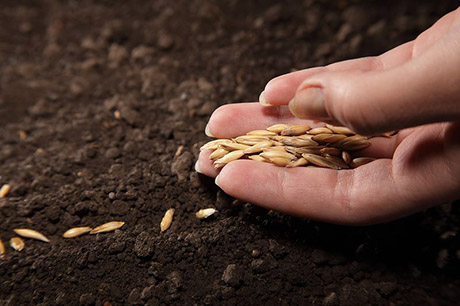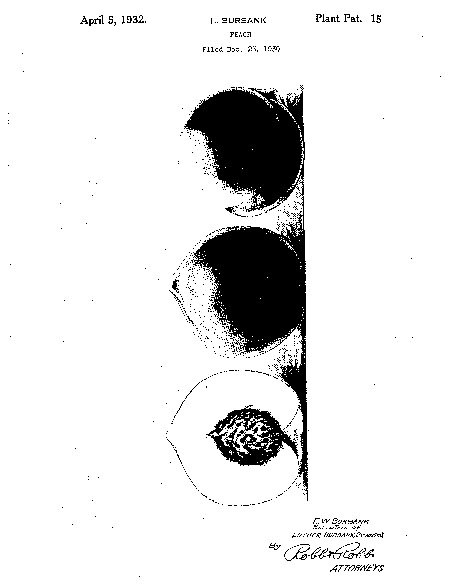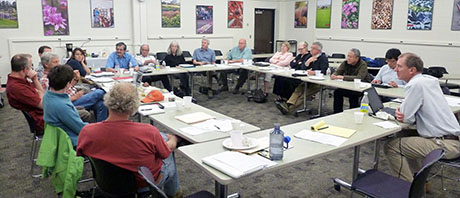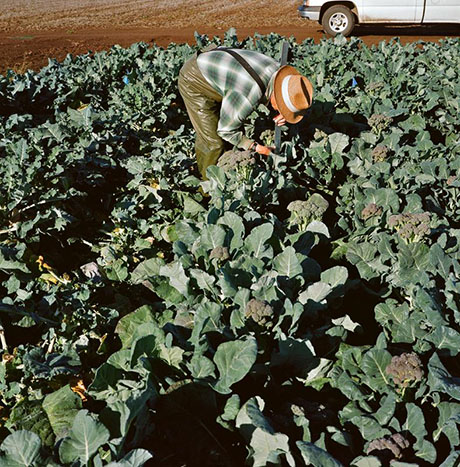
People who sell seeds have always struggled with an inconvenient reality: Their merchandise reproduces itself.
So writes Lisa Hamilton, one of my fellow Fellows from the inaugural UC Berkeley/11th Hour Food & Farming Fellowship programme, summing up a problem that plant breeders have struggled with for generations: how to monetise the effort and ingenuity embedded in their work.
As Hamilton’s article, published in the June issue of the Virginia Quarterly Review, describes, since the passing of the Plant Patent Act of 1930, breeders have relied on intellectual property law in order to profit from the years they invest in developing a useful characteristic in a plant — an easier-to-harvest broccoli, or a lycopene-rich red carrot.
In order for seeds to become a commodity and generate a profit, there had to be a reason for people to buy them year after year. Over the course of the twentieth century, the industry devised certain solutions, including hybrid seeds and “trade-secret” protections for their breeding processes and materials. But perhaps the most effective solution is the application of intellectual-property rights, of which the utility patent is the gold standard.
Before the Plant Patent Act, plant breeders complained bitterly that the reward for their achievements was frequently obscurity and poverty, in contrast to the fortunes being reaped by mechanical inventors such as Thomas Edison and Alexander Graham Bell.
Luther Burbank, the first (and perhaps only) celebrity plant breeder, many of whose new fruit and vegetable varieties still fill our plates today, died before the Plant Patent Act was introduced, and frequently despaired over his inability to make a profit:
A man can patent a mouse trap or copyright a nasty song, but if he gives to the world a new fruit that will add millions to the value of the earth’s harvests he will be fortunate if he is rewarded by so much as having his name connected with the result…. I would hesitate to advise a young man, no matter how gifted or devoted, to adopt plant breeding as a life work until America takes some action to protest his unquestioned rights to some benefit from his achievements.

IMAGE: Application for Plant Patent 15, “Peach,” filed posthumously by Luther Burbank’s widow on December 23, 1930.
But, as Hamilton explains, while the utility patent may have made plant breeding profitable enough for the multinational likes of Monsanto and Syngenta, the application of intellectual property law to nature is not without problems, from the eminently practical (it tends to constrain seed-sharing, which ultimately hinders “the very resilience of agriculture itself”) to the philosophical (can an element of the natural world, however much altered and “improved” upon by human ingenuity, really be owned by an individual?).
Her article, which you really need to read in full, looks at one renegade group of plant breeders who have banded together to launch a challenge to the prevailing model of seed IP: the Open Source Seed Initiative, which released its first open-source, un-patentable broccoli, kale, and celery seeds this past April.

IMAGE: A meeting of the Open Source Seed Initiative Group at the University of Minnesota in 2012, from the group’s website.
Missing from the final article, in the interests of streamlining, was one of my favourite anecdotes from Hamilton’s reporting: the carrot hack. The doctoral thesis project of Claire Luby at the University of Wisconsin, the carrot hack proceeds in the reverse direction to conventional plant breeding. As Hamilton explained to us, Luby is effectively “un-breeding” the American commercial carrot in order to free its genetic code for remixing:
The mesh bags represent the project’s first stage, for which she grew every commercially available carrot variety in the United States. There are 144 in all, ranging from the knobby French heirloom Tonda di Parigi to CrispyCut, a ten-inch long variety designed to be lathed into baby carrots.
Because carrots are biennial, they require two seasons to reproduce: during the first they grow their nutritious root, during the second they flower and produce seed. Luby is storing her harvest in the adjacent cold room, whose temperature of 41 degrees F will trick the plants into thinking they have passed through winter in two months. After Thanksgiving, for the project’s second stage, she will plant them in the greenhouse. As they flower, she will introduce ten thousand flies to cross-pollinate them en masse.
This is the opposite of what her fellow students will be doing this winter. They will mate specific pairs of plants to breed more targeted individuals. Luby will effectively un-breed her carrots, mixing their genes at random into a population that is wildly heterogeneous. The idea is to capture the entire range of genetics used in commercial carrots within a single collection. Breeders can then use that seed to produce new varieties. There’s only one catch: those new varieties can never be patented. That’s because Luby’s seed will be open source.
It’s an incredibly ingenious idea that, predictably, has not gone perfectly smoothly. In discussion with University of Wisconsin lawyers, Seminis (the largest developer of fruit and vegetable seeds in the world, purchased by Monsanto in 2005) banned Luby from using its carrot germplasm. In the end, more than a third of the original 144 carrot varieties cannot be included in the open-source mash-up due to corporate restrictions. However, Hamilton told us, there’s still hope, because many commercial carrots come from the same original stock, and thus still share DNA:
By comparing DNA markers, Luby will map out where the carrots’ genes overlap. It’s possible that the seeds she can use will contribute many genes that are also found in the seeds she can’t use.
Hamilton’s reporting on this story is an important wake-up call to those of us who have never considered how seed IP affects what we eat, both now and in the future. It’s a complicated issue, and, as a result, growing corporate control of germplasm, and its equally problematic counterpart, declining public investment in plant breeding, rarely make headlines.
But, although it’s unclear yet whether the Open Source Seed Initiative or Claire Luby’s carrot hack can provide a viable alternative model to plant patents, what is utterly fascinating about Hamilton’s article is the way it demonstrates the importance of metaphor in opening new possibilities for imagining the world, and constraining others.

IMAGE: Jim Myers, professor of vegetable breeding and genetics at Oregon State University, photographed in a broccoli field at the university’s research farm by Lisa Hamilton.
Seeing seeds as software, for example, inspires certain solutions (a carrot hack! Linux for lettuce!) but creates other problems (how does licensing enforcement work when the open-source genetics are not marked in any way?). Elsewhere in Hamilton’s article, breeders refer to the idea of a “national park of germplasm” — a “genetic easement” that preserves, un-patented, enough of the important DNA of, say, commercial carrot varieties, for future generations of plant breeders, growers, and eaters. This idea of the natural world as a protected commons offers, in turn, its own set of tools and limitations.
In the end, it seems that one of the more valuable contribution those of us who are concerned about seed IP could make would be the gift of a new set of metaphors, to re-imagine how we relate to the natural world we make.
5 Comments
Thank you for compiling and sharing this really interesting information. I was only recently informed about the existence and activities of the Open Source Seed Alliance so I started digging up on its background and related initiatives; your article was one of the first that came up after a small research!
We have used this post as a reference in a related blog post that we just published, titled: Open Sourcing Plant Seeds – The Open Source Seed Initiative & similar efforts (http://blog.agro-know.com/?p=1147). Feel free to visit and comment!
Thanks – we’ll be keeping an eye of the future posts through the RSS feed from now on!
Really cool stuff here. Interesting ways to think about GMO vs. breeder foods. By opening the carrot seed hack, are we inviting more risk with GMO-type work? I wonder who will be the people benefiting from open source seeds.
Great post, Nicky. Thanks for your thoughtful insights.
I just had to add a little footnote about Luther Burbank, because it turns out that he actually opposed patenting, at least early on. Writing in The Journal of the Patent and Trademark Office Society, Cary Fowler (the brain behind Svalbard) suggested that Burbank’s words were twisted for the immense support they might engender in the public. Fowler explained:
“Burbank had early on voiced his opposition to patents. In a pamphlet entitled, How to Judge Novelties, published in 1911, he stated: No patent can be obtained on any improvement of plants, and for one I am glad that it is so. The reward is in the joy of having done good work, and the impotent envy and jealousy of those who know nothing of the labor and sacrifices necessary, and who are by nature and cultivation, kickers rather than lifters. Happening however to be endowed with a fair business capacity I have so far never been stranded as have most others who have attempted similar work, even on an almost infinitely smaller scale.”
The quote that plant patent boosters used (which you quote above) was submitted by Burbank’s widow after the famous plant breeder died. I can’t help but wonder what Burbank would have said had he been alive, or what kind of little personal drama lies behind his widow’s submitting a misleading letter of support. Or, whether, perhaps, Burbank changed his mind over time.
This post and the excellent links is an extraordinarily helpful contribution to this topic, thank you so much. Will be sharing widely.
For folks interested in the longer history of seed ‘enclosures’ through combined legal (IP) and biological (hybrid breeding) mechanisms, you can’t do better than Jack Kloppenburg’s First the Seed: The Political Economy of Plant Biotechnology.
Kloppenburg is also a founder of OSSI, a concept he explains lucidly in this journal article: Kloppenburg, J. (2010). Impeding dispossession, enabling repossession: biological open source and the recovery of seed sovereignty. Journal of agrarian change, 10(3), 367-388.